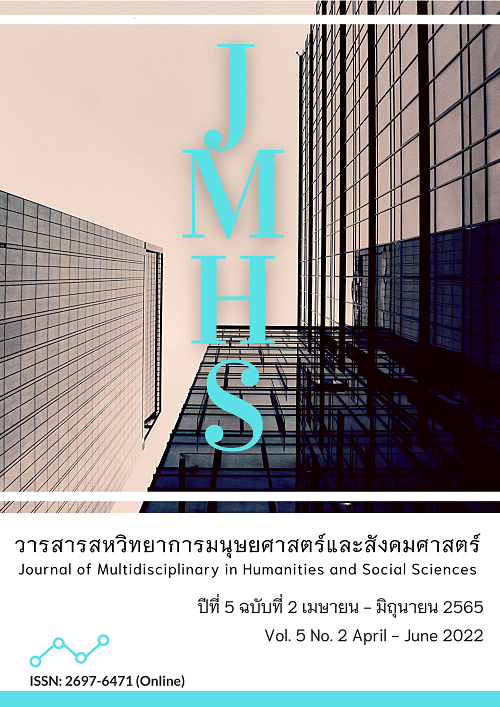An Analytical Study of The Suffering in The Aghamula Sutta Related of Vipassana Meditation Practice
Main Article Content
Abstract
The objectives of this article were 1) to study the content and teaching that appeared in Aghamul Sutta and (2) to study the suffering in Aghamul Sutta related to Vipassana meditation practice. The studied data was taken from Theravada Buddhist scriptures and other related documents, summarized, analyzed, and compiled in a descriptive style. The results showed that As for suffering in Aghamul Sutta related to meditation practice, it refers to the knowledge occured from observing the five aggregates clinging, namely: 1) The practitioner observes the perception as suffering in which the objectives of insight, that is all forms are temporary, ever-changing, and disintegrated, as a cause of suffering, seeing what is impermanent is also suffering. 2) He observes suffering of feeling which contains sensual knowable agent that has a temperament arisen with consciousness. 3) He knows the suffering of perception characterized by emotional memory, arisen in the same with consciousness as the cause of suffering by realizing it as origin of suffering. 4) The practitioner observes suffering of Sankhara or thought while receiving sensual objects, in which thought will shape the mind to be in accordance with the thought types. and 5) He observes suffering of consciousness with wholesome and unwholesome types, which causes suffering. For Vipassana meditation mode, the practitioner should renounce 3 causes of suffering: 1) Kamatanha, 2) Bhavatanha, and 3) Vibhavatanha. These all cravings should be abandoned inherent 108 craving abandoning will lead the mind of the Vipassana practitioner to progress to the higher level for attaining the Noble Path and Fruits in the end.
Article Details

This work is licensed under a Creative Commons Attribution-NonCommercial-NoDerivatives 4.0 International License.
Views and opinions appearing in the Journal it is the responsibility of the author of the article, and does not constitute the view and responsibility of the editorial team.
References
พระพรหมคุณาภรณ์ (ป.อ.ปยุตฺโต). (2551). พจนานุกรมพุทธศาสตร์ ฉบับประมวลธรรม. (พิมพ์ครั้งที่ 12). กรุงเทพฯ: โรงพิมพ์มหาจุฬาลงกรณราชวิทยาลัย.
พระพุทธโฆสเถระ. (2554). คัมภีร์วิสุทธิมรรค. (สมเด็จพระพุฒาจารย์ (อาจ อาสภมหาเถร), ผู้แปล). (พิมพ์ครั้งที่ 6). กรุงเทพฯ: ธนาเพรส.
พระมหาเกริกสัน ญาณสมฺปนฺโน, พระปลัดสมชาย ปโยโค และ พระมหาวีรธิษณ์ วรินฺโท. (2563). ศึกษาวิเคราะห์ตบะในคัมภีร์มังคลัตถทีปนี. วารสาร มจร พุทธปัญญาปริทรรศน์, 5(1), 43-52.
พระสมชาย บัวแก้ว, พระมหาบุญศรี วงค์แก้ว และ สุเชาวน์ พลอยชุม. (2564). อภิสมาจาร: กระบวนการพัฒนาบุคลิกภาพตามแนวพระพุทธศาสนา. วารสารศิลปการจัดการ, 5(3), 895-907.
พระสัทธัมมโชติกะ ธัมมาจริยะ. (2544). ปรมัตถโชติกะ ปริจเฉทที่ 3 และปริจเฉทที่ 7. (พิมพ์ครั้งที่ 6). กรุงเทพฯ: โรงพิมพ์ทิพย์วิสุทธิ์.
พระโสภณมหาเถระ (มหาสียาดอ). (2555). วิปัสสนานัย เล่ม 1. (พระคันธสาราภิวงศ์, ผู้แปล). นนทบุรี: ไทยร่มเกล้า.
มหาจุฬาลงกรณราชวิทยาลัย. (2539). พระไตรปิฎกภาษาไทย ฉบับมหาจุฬาลงกรณราชวิทยาลัย. กรุงเทพฯ: โรงพิมพ์มหาจุฬาลงกรณราชวิทยาลัย.
มหาจุฬาลงกรณราชวิทยาลัย. (2552). อรรถกถาภาษาไทย ฉบับมหาจุฬาลงกรณราชวิทยาลัย. กรุงเทพฯ: โรงพิมพ์มหาจุฬาลงกรณราชวิทยาลัย.
มูลนิธิภูมิพโลภิกขุ. (2523). สัททนีติปกรณ์ ธาตุมาลา. กรุงเทพฯ: โรงพิมพ์มูลนิธิภูมิพโลภิกขุ.
อรชร ไกรจักร์, เเม่ชีกฤษณา รักษาโฉม และ พระมหาวรัญธรณ์ ญาณกิตฺติ. (2564). บุคลิกภาพของพระภิกษุตามหลักเวสารัชชกรณธรรม. วารสาร มจร บาฬีศึกษาพุทธโฆสปริทรรศน์, 7(3), 113-125.
Damnoen, P.S. (2021). The Development of Student Characteristics in According to the Nawaluk Framework of the Buddhist integration of Buddhapanya Sri Thawarawadee Buddhist College. Asia Pacific Journal of Religions and Cultures, 5(2), 126-135.
Tan, C.C., & Damnoen, P.S. (2020). Buddhist Noble Eightfold Path Approach in the Study of Consumer and Organizational Behaviors. Journal of MCU Peace Studies, 8(1), 1-20.


